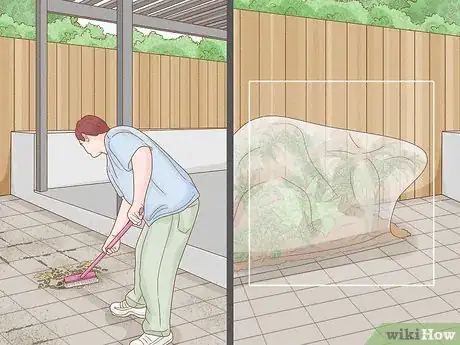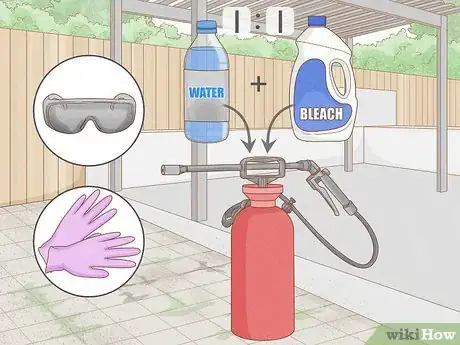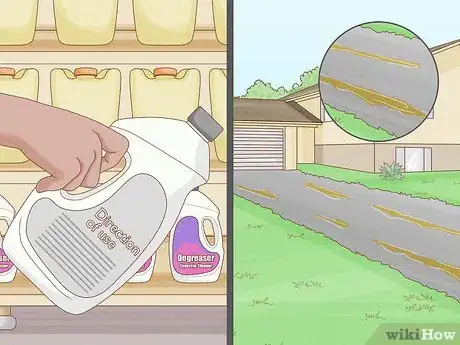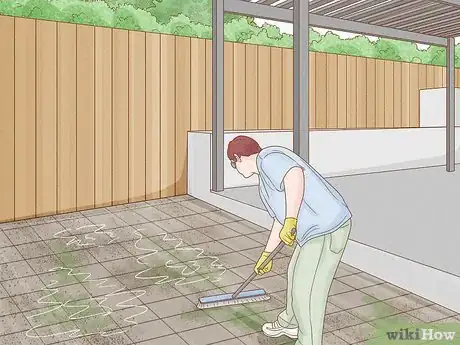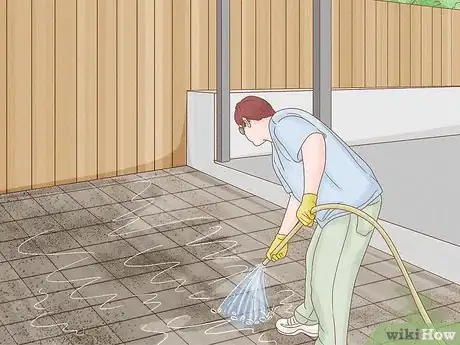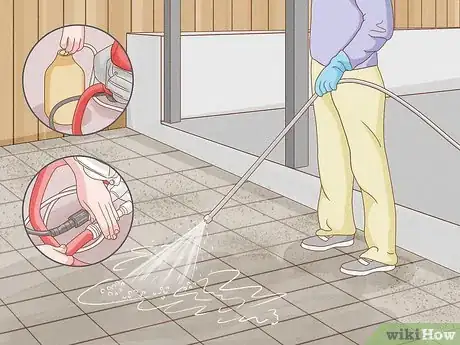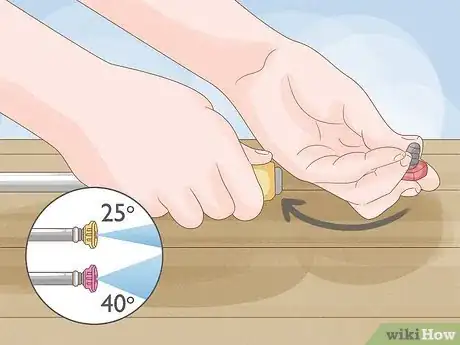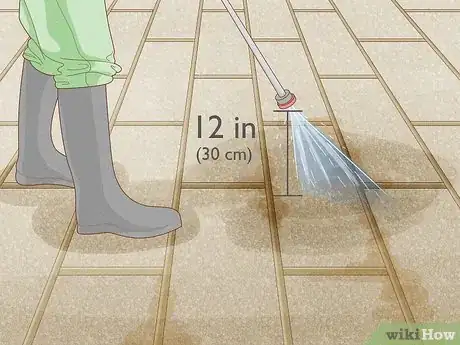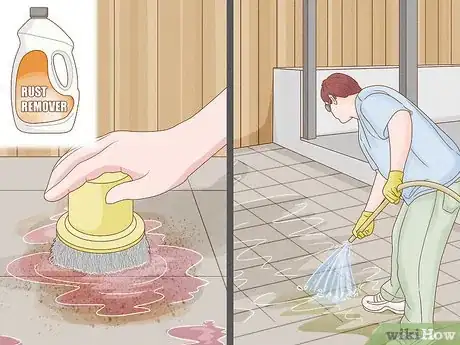This article was co-authored by Jeff Baldwin and by wikiHow staff writer, Jessica Gibson. Jeff Baldwin is a Residential Painter and the Owner of Baldwin Custom Painting. With two decades of painting experience, Jeff specializes in high-end residential and small commercial painting projects. Dedicated to quality craftsmanship, Jeff and Baldwin Custom Painting provide bonded/insured, licensed, and lead-safe certified services in residential painting, light commercial painting, and wood refinishing.
There are 13 references cited in this article, which can be found at the bottom of the page.
This article has been viewed 6,672 times.
If you're renovating your patio or yard, don't forget the concrete! Dark, fuzzy, or stained concrete can age your space. Fortunately, it only takes a little time to whiten it so it looks new again. You've probably heard that pressure washing is great for getting your concrete white, and while that's true, you might try cleaning with a bleach solution first. This way, you can avoid excess wear on the concrete while lifting stains.
Steps
Spraying a Commercial Product
-
1Sweep the concrete and cover anything you don't want to bleach. Get everything off of the concrete—cars, furniture, planters—and sweep up dust and debris like leaves. Then, cover plants, cords, or outlets with a tarp or plastic sheeting so they don't get bleached or wet.[1]
- Keep kids and pets away while you use the bleach. You don't want them breathing in the fumes.
-
2Fill a garden sprayer with diluted bleach if you've got organic stains. Pour equal parts of water and bleach into the garden spray container—this diluted solution will remove organic stains like moss, green algae, and black algae.[2]
- Pop on a pair of gloves and safety goggles when you begin working with the bleach to protect your skin and eyes from irritation.
Advertisement -
3Use an acidic concrete cleaner to remove rust. Unfortunately, bleach won't get rid of rust stains on concrete. Buy a commercial concrete cleaner that's designed to remove rust. It will also remove dirt and salt stains. Dilute the product according to the manufacturer's instructions and pour it into an empty garden spay container.[3]
- Don't feel like buying a commercial product? Try using equal parts lemon juice and white vinegar. This creates a similar acidic solution that could lift your rust stains.[4]
- For instance, you might use 1 part cleaning product with 10 parts water.
-
4Choose a degreasing product if you have oil stains. Shop for a concrete cleaner that's a degreaser if you're cleaning a driveway or garage that's got oil stains. These products break down the hydrocarbons in the oil so you can thoroughly clean the concrete. Dilute the product according to the manufacturer's instructions or spray it directly onto tough stains.[5]
-
5Spray your product on the concrete and let it sit for 5 to 10 minutes. Pump your garden spray to build pressure and press down on the wand release to spray the product. Coat your concrete with the product so the surface is totally saturated and it doesn't dry right away. Try to work in small areas so you can scrub and rinse before the product dries.[6]
- If you're cleaning concrete indoors, open all the windows and doors in the room to get some circulation.
-
6Scrub the concrete with a push broom for a deeper clean. Sure, you don't have to scrub if you're using a commercial product, but it really can help to lift old, heavy stains. Take a push broom or use a long-handled brush to scrub the entire surface—get into the corners and along the edges, too.[7]
- If you only scrub a few areas, you may get patchy whitening.
-
7Rinse the concrete with water. Use a garden hose to spray the concrete and remove the bleach, rust cleaner, or degreaser. Then, just let the concrete dry![8]
- If you're removing very old stains, you might have to repeat the process again to really get the concrete white.
- If you got the product on the nearby grass or your shoes, don't forget to rinse them, too.
Pressure Washing
-
1Put on safety goggles and start with clean concrete. Sweep the entire surface to get rid of dust, dirt, and debris like leaves. Pressure washing is even more effective if you've already cleaned the concrete with a commercial product or stain remover, but it's completely fine to apply a product as you pressure wash. Don't forget to pop on safety goggles and earplugs.[9]
- Wear long pants and closed-toed shoes when you operate the pressure washer.
- If there are plants near the concrete that you don't want to accidentally get, toss a tarp over them before you begin.
-
2Spray a cleaning product onto the surface if the concrete is dirty. Stick the siphon hose of your pressure washer into a container of concrete cleaner. Then, hook up your garden hose to the machine and push the cleaning spray tip onto the end of the wand. If your washer didn't come with a designated cleaning tip, use a wide, fan-nozzle tip. Turn on the washer and hold the wand 18 to 24 inches (46 to 61 cm) above the surface as you sweep it back and forth to coat the concrete with soapy water.[10]
- Use a pressure washer that's at least 3000psi so you can really clean the surface of the concrete.[11]
- You can use any standard concrete cleaner that's available at janitorial supply shops or hardware stores.
- Any paint stains can be removed by applying latex paint remover before using a pressure washer. [12]
- It's fine to skip this step if you already tried removing stains with bleach, degreaser, or a rust-removing product.
-
3Install a 25- or 40-degree tip to the wand. Your pressure washer should come with several tips so you can use the pressure washer for different applications. To clean concrete and remove most stains, a 25-degree tip should be fine. If you don't have stubborn stains and want to simply wash the concrete, go for a 40-degree tip.[13]
- Avoid using the really narrow 0- or 15-degree tips since these will strip or damage your concrete.
-
4Sweep the pressure washer wand evenly over the surface. Stand at the highest point and work your way down so the water drains off the concrete. Keep the wand at least 12 inches (30 cm) above the surface so you don't damage the concrete. Overlap your passes so you don't have gaps between where you've pressure washed.
- Take your time! If you rush, you might see thin, white streaks.
-
5Spot treat stubborn stains that might be left. If you've gone over the entire surface, but still see spots or stains, don't worry! Spray a commercial cleaning product like a degreaser or rust remover directly on the spot.[14] Scrub it with a bristle brush and rinse it off using the pressure washer.[15]
- Check along edges and corners, too. These are often dirtier than large patches of concrete.
Expert Q&A
-
QuestionWhat is the easiest way to remove paint from concrete?
 Jeff BaldwinJeff Baldwin is a Residential Painter and the Owner of Baldwin Custom Painting. With two decades of painting experience, Jeff specializes in high-end residential and small commercial painting projects. Dedicated to quality craftsmanship, Jeff and Baldwin Custom Painting provide bonded/insured, licensed, and lead-safe certified services in residential painting, light commercial painting, and wood refinishing.
Jeff BaldwinJeff Baldwin is a Residential Painter and the Owner of Baldwin Custom Painting. With two decades of painting experience, Jeff specializes in high-end residential and small commercial painting projects. Dedicated to quality craftsmanship, Jeff and Baldwin Custom Painting provide bonded/insured, licensed, and lead-safe certified services in residential painting, light commercial painting, and wood refinishing.
Residential Painter The best way to remove paint from concrete is with a pressure washer if you have one. You can also use a wire brush and latex paint remover, and rinse clean using a pressure washer. Stained, stamped concrete should be pressure washed, or cleaned with latex paint remover and a cloth.
The best way to remove paint from concrete is with a pressure washer if you have one. You can also use a wire brush and latex paint remover, and rinse clean using a pressure washer. Stained, stamped concrete should be pressure washed, or cleaned with latex paint remover and a cloth. -
QuestionHow do you remove paint primer from concrete?
 Jeff BaldwinJeff Baldwin is a Residential Painter and the Owner of Baldwin Custom Painting. With two decades of painting experience, Jeff specializes in high-end residential and small commercial painting projects. Dedicated to quality craftsmanship, Jeff and Baldwin Custom Painting provide bonded/insured, licensed, and lead-safe certified services in residential painting, light commercial painting, and wood refinishing.
Jeff BaldwinJeff Baldwin is a Residential Painter and the Owner of Baldwin Custom Painting. With two decades of painting experience, Jeff specializes in high-end residential and small commercial painting projects. Dedicated to quality craftsmanship, Jeff and Baldwin Custom Painting provide bonded/insured, licensed, and lead-safe certified services in residential painting, light commercial painting, and wood refinishing.
Residential Painter The best way to remove primer depends on what kind of primer was used. There are different kinds of paint primer remover. For concrete, you can use chemical solvents such as caustic stripping agents to remove the primer paint. Be sure to wear protective eyewear, a dust mask, and thick rubber gloves.
The best way to remove primer depends on what kind of primer was used. There are different kinds of paint primer remover. For concrete, you can use chemical solvents such as caustic stripping agents to remove the primer paint. Be sure to wear protective eyewear, a dust mask, and thick rubber gloves.
Things You'll Need
Spraying a Commercial Product
- Garden sprayer
- Safety goggles
- Gloves
- Push broom
- Tarp or plastic covering
- Bleach, concrete rust cleaner, or degreasing concrete cleaner
- Garden hose
Pressure Washing
- Pressure washer
- Safety goggles
- Gloves
- Earplugs
- Commercial cleaning product
- Bristle brush
- Garden hose
References
- ↑ https://youtu.be/pm_-GpjN2Fw?t=329
- ↑ https://youtu.be/rU6jzrXuwo4?t=41
- ↑ https://youtu.be/pm_-GpjN2Fw?t=151
- ↑ https://cleaning.lovetoknow.com/outdoor-cleaning/how-remove-old-new-rust-stains-from-concrete
- ↑ https://youtu.be/pm_-GpjN2Fw?t=169
- ↑ https://youtu.be/rU6jzrXuwo4?t=103
- ↑ https://youtu.be/rU6jzrXuwo4?t=114
- ↑ https://youtu.be/rU6jzrXuwo4?t=127
- ↑ https://youtu.be/swb14AJ4baU?t=46
- ↑ https://youtu.be/swb14AJ4baU?t=128
- ↑ Jeff Baldwin. Residential Painter. Expert Interview. 1 March 2021.
- ↑ Jeff Baldwin. Residential Painter. Expert Interview. 1 March 2021.
- ↑ https://www.pressure-pro.com/wp-content/uploads/2017/03/PRESSURE_WASHER_MANUAL_HR.pdf
- ↑ https://youtu.be/swb14AJ4baU?t=184
- ↑ Jeff Baldwin. Residential Painter. Expert Interview. 1 March 2021.
